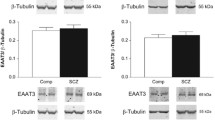Summary.
We used cerebral cortex injections of fluorocitrate to determine if selective astrocytic disturbances affect the electroencephalogram (EEG). Rats were halothane-anaesthetized and 0.8 nmol of sodium fluorocitrate was injected into hindlimb (motor-sensory) cortex. Extra-dural EEG electrodes were implanted after which the anaesthesia was ceased. EEG was recorded at 1, 3, 5, 7, 24 and 48 hours. There was a broad-band reduction in frequencies in the EEG between 20 and 100 Hz commencing within 1 hour of injection and largely restricted to the side of injection and to frontal cortex, and maximal at 3 hours. Halothane had a suppressive effect on gamma power after citrate injection, but also prevented EEG suppression caused by fluorocitrate, consistent with the hypothesis that some of the action of fluorocitrate depended on gap-junctions. The findings are consistent with the hypothesis that primary astroglial dysfunction leads to reduced neuronal transmission and further supports gap-junctions as mediating fluorocitrate-induced astroglial effects.
Similar content being viewed by others
Author information
Authors and Affiliations
Rights and permissions
About this article
Cite this article
Willoughby, J., Mackenzie, L., Pope, K. et al. Localised astroglial dysfunction disrupts high-frequency EEG rhythms. J Neural Transm 112, 205–213 (2005). https://doi.org/10.1007/s00702-004-0189-9
Received:
Accepted:
Published:
Issue Date:
DOI: https://doi.org/10.1007/s00702-004-0189-9




